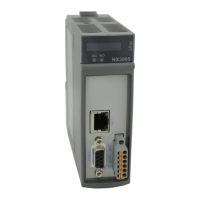6. REDUNDANCY WITH NX3030 CPU
6.3. Principles of Operation
In this section, the redundant CPU functions using a NX3030 CPU is described, along with its behavior and states. It’s also
presented concepts and programming and configuration restrictions that will be used in the next sections.
6.3.1. Identification of an NX3030 CPU
A NX3030 CPU has a non-volatile identification register where it’s possible for it to be identified as:
Non-redundant: it can’t be used in a redundant CPU (default configuration)
PLCA: used in the redundant CPU PLCA
PLCB: used in the redundant CPU PLCB
The identification register can be adjusted using the MasterTool programmer. The first thing to be done in a NX3030 CPU,
before downloading the redundant project in it, is to identify it as PLCA or PLCB. In case the identification isn’t executed,
several redundancy features won’t work correctly, as, for instance, the synchronization of the application between the PLCs.
ATTENTION
The CPU identification register is not part of the redundant CPU project, thus it isn’t saved
as part of this project in the computer where MasterTool is being executed. The register is
saved only in the non-volatile CPU memory.
6.3.2. Single Redundant Project
Due to the identification register previously described, there’s a single project for the redundant CPU, identical for both
PLCA and PLCB.
Configuration parameters that must be different for PLCA and PLCB (e.g. Ethernet interface IP address) appear doubled
in the redundant CPU project (one for the PLCA and another for the PLCB). Each CPU will consider the correspondent one,
after analyzing its identification register.
6.3.3. Redundant Project Structure
6.3.3.1. Redundancy Template
A redundant CPU project is created automatically from a model, called Redundancy Template.
The template starts from the minimum redundant CPU configuration, as defined in the Minimum Configuration of a
Redundant CPU (Not Using PX2612 Panel) section. Besides this, some dialogs with the user are made for the insertion of
additional modules in the half-clusters, such as PROFIBUS masters (NX5001) and Ethernet modules (NX5000).
PROFIBUS remotes must be inserted by the user, below the NX5001 PROFIBUS masters already inserted.
Furthermore, tasks and basic POUs from the program type are created, as described in the following sections.
6.3.3.2. Single and Cyclic Task MainTask
The redundant CPU project has a single task, called MainTask, which is cyclic. The user can adjust the task cycle time.
6.3.3.3. MainPrg Program
The MainTask is connected to a single POU from the program type, called MainPrg. The MainPrg program is created
automatically.
The MainPrg code is the following, in ST language:
SpecialVariablesPrg();
IF isFirstCycle THEN
StartPrg();
isFirstCycle := FALSE;
ELSE
fbRedundancyManagement();
279

